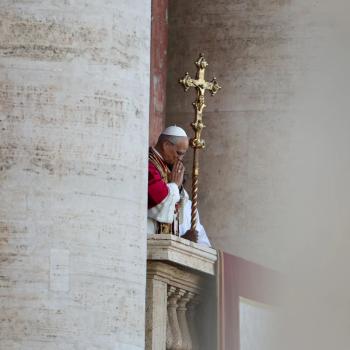Editors' Note: This article is part of the Patheos Public Square on the Future of Faith in America: New Religions. Read other perspectives here.
Malcolm Muggeridge, a prominent 20th-century journalist, once wryly confessed that if he had been a news correspondent in the Holy Land in the time of Jesus, he probably would have missed the most significant news event of all time. "Almost certainly," Muggeridge remarked, he would have spent his time cultivating "the entourage of Pontius Pilate" and "looking about Herod's court." How many contemporaries recognized that the life of Jesus — an obscure religious teacher without wealth, social standing, or political connections — would still be transforming human lives two millennia later?
The world has never been particularly good at recognizing what is spiritually significant and lasting.
Even in the years of Jesus' public ministry, when multitudes flocked to him for healing, few grasped the nature or magnitude of the spiritual message shown in those healing works. In the aftermath of the crucifixion, even Jesus' devoted followers struggled in the belief that the hopes raised by his ministry had apparently been misplaced.
"We trusted that it had been he which should have redeemed Israel," two of them told a stranger sadly as they walked together to a nearby village called Emmaus. The stranger, referring to the Scriptures, reminded them of the larger spiritual perspectives that Jesus' life and teaching had opened up, and only after he left, according to the Gospel of Luke, did they realize, with burning hearts, who they had been speaking with.
For Christian Scientists in 2015, these are times when the largest spiritual perspectives are equally needed — and deeply stirring.
Christian Science began as a movement of spiritual awakening. The church was organized in 1879 with a couple dozen members and the audacious spiritual mission to "reinstate primitive Christianity and its lost element of healing." The church's leader and first pastor, Mary Baker Eddy, was a middle-aged woman of modest means and education whose life changed radically when she was healed after many years of invalidism. Few observers at the time would have singled out Eddy and her followers as likely to rise from obscurity into a movement of significant proportions.
Four years earlier, in the Preface of the work that became known as the church's textbook, Science and Health with Key to the Scriptures, she had introduced this religious movement to the world with an even more startling announcement: "The time for thinkers has come," she wrote, adding in the first edition, "and the time for revolutions, ecclesiastic and social, must come."
In the troubled religious environment of the 21st century, it's clear that she was right on both counts. The secular direction of society has challenged both the head and the heart of Christianity. For thinking people, religious dogmatism is self-discrediting. For many, science and technology have largely replaced religion as an explanation of life.
For Eddy, Jesus' answer to the mortal predicament was not a dogma, but a life. She saw Jesus' life — not least his resurrection and healing works — as challenging the core materialism that most of the sciences take for granted. "With truths so counter to the common convictions of mankind," she believed, Christianity must be practical, not merely theoretical, bearing witness by Christians' own lives and healing works that God's love is not a mildly comforting concept, but a power.
Eddy removed the reference to "revolutions" from the Preface in later editions of Science and Health, but she never relinquished her conviction that "Christ's Christianity" is spiritually revolutionary and utterly transforming in its effects both in individual lives and, ultimately, in the wider life of humanity.
Like other Christians, Christian Scientists today face the stiff cultural headwinds documented in the Pew Report on religious trends. In the past half-century, the denomination has declined substantially in size. Like those faith-challenged disciples on the way to Emmaus, Christian Scientists have sometimes struggled to "keep the faith" in small churches and discouraging outward circumstances. And yet, perhaps more than many, they have reason to look beyond outward trends to the deeper, spiritual sources of light and renewal that "grew" their churches in the first place.
Movements of spiritual awakening often need to be reawakened and renewed themselves. For churches as for individuals, renewal requires recognizing shortcomings, repenting of mistakes, and catching a larger vision of spiritual reality and possibility. Confronted by the difficulties of recent years, many Christian Scientists have thought more deeply about the nature of their church and its purpose in the world. This rethinking and renewal extends to Christian Scientists' ministry of healing — the spiritual heart of their practice, the most widely known element of Christian Science, and by far the most attacked and misunderstood.




